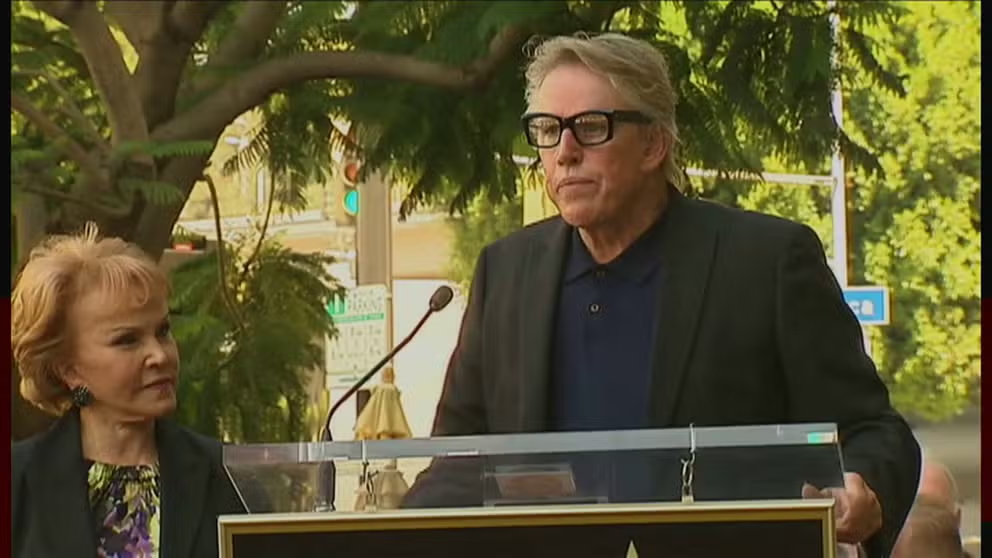What caused Buddy Holly’s plane to crash 65 years ago: The day that music died
Holly, two other musicians and a pilot died in a plane crash in Iowa in February 1959. Poor weather reports and the pilot underestimating the severity of the weather led to the crash, investigators found.
Buddy Holly earned a star in Hollywood, accepted by his widow
Gary Busey, who played Buddy Holly, in the movie of his life, and widow Maria Elena Holly speak at the posthumous award to Holly of a star on the Hollywood Walk of Fame in 2011.
So many sing about "the day that music died" on Feb. 3, 1959, when Buddy Holly, Ritchie Valens and J.P. "The Big Bopper" Richardson were killed in a plane crash.
Don McLean coined the term in his 1971 hit "American Pie." The song about the decline of the 60s starts with the death of the three young musicians, "the end of the happy 50s," he told Forbes Magazine.
Investigators point to quickly-changing wintry weather conditions that were not communicated to the inexperienced pilot as the cause of the crash that left such a tragic mark on music history.

The wreckage of the plane crash that killed rock stars Buddy Holly (Charles Hardin Holley), Ritchie Valens (Richard Steven Valenzuela), and The Big Bopper (Jiles Perry Richardson, Jr.) On February 3, 1959 outside of Clearlake, Iowa.
(Michael Ochs Archives / Getty Images)
"It is believed that shortly after takeoff, pilot Peterson entered an area of complete darkness and one in which there was no definite horizon; that the snow conditions and the lack of horizon (visual of the ground) required him to rely solely on flight instruments for aircraft attitude and orientation," wrote the Civil Aeronautics Board charged with investigating the crash.
Tough bus rides on the Winter Dance Party tour, musicians getting sick
The musicians had just finished a leg of the "Winter Dance Party" tour at the Surf Ballroom in Clear Lake, Iowa, on the evening of Feb. 2.
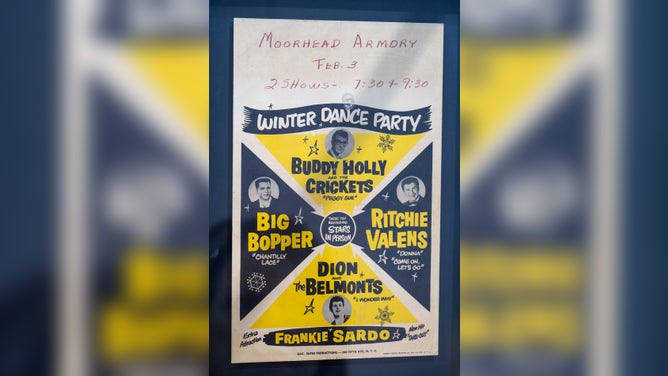
File: An original poster for the Winter Dance Party which was supposed to feature Buddy Holly, Ritchie Valens and the Big Bopper. The three crashed that morning.
(David Crane/MediaNews Group/Los Angeles Daily News / Getty Images)
The 24-day tour kicked off in Milwaukee, Wisconsin and crisscrossed Wisconsin, Minnesota and Iowa in the dead of winter.
"Organizationally speaking, the tour was a complete catastrophe. The shows were often scheduled hundreds of miles apart from one another as they zigzagged through one of the deadliest winters the Midwest had seen in decades, in the worst possible transportation available," states the ballroom’s website. "The musicians crammed into a drafty bus to perform in small ballrooms and theaters, and by February 1st, Carl Bunch (Holly’s drummer) had left with frostbitten feet."
TAYLOR SWIFT HAS ERA OF BAD WEATHER FOR CONCERTS THIS TOUR SEASON

File: Buddy Holly and the Crickets perform on the Ed Sullivan Show at the Ed Sullivan Theater on January 26, 1958 in New York City.
(Steve Oroz/Michael Ochs Archives / Getty Images)
Holly, the 22-year-old driving force of the tour, had enough of broken down busses in freezing temperatures and chartered a four-seater plane to get to the show the next night in Morehead, Minnesota, according to the Civil Aeronautics Board’s Accident Report. Fargo, North Dakota, was the nearest airport.
The musician asked his guitarist, Tommy Allsup, and his bass guitarist, Waylon Jennings, to join. The tour included Valens, Richardson, Dion and the Belmonts, Frankie Sardo, Jennings, Allsup and Bunch.
The 17-year-old Valens had never been on a small plane before and asked Allsup for his seat, according to the Encyclopedia of Oklahoma History and Culture. The two flipped a coin, and Valens "won" the seat.

File: Ritchie Valens (Richard Steven Valenzuela) performs on a TV show in 1958 in Los Angeles.
(Michael Ochs Archives / Getty Images)
Jennings gave up his seat to flu-addled Richardson, according to the accident report. Jennings told the Country Music Hall of Fame that his last conversation with Holly would always haunt him, even though the words were in jest.
After Jennings told Holly that he wouldn’t be on the plane, Holly said, "I hope your dammed bus freezes up again."
Jennings replied, "I hope your ole plane crashes."
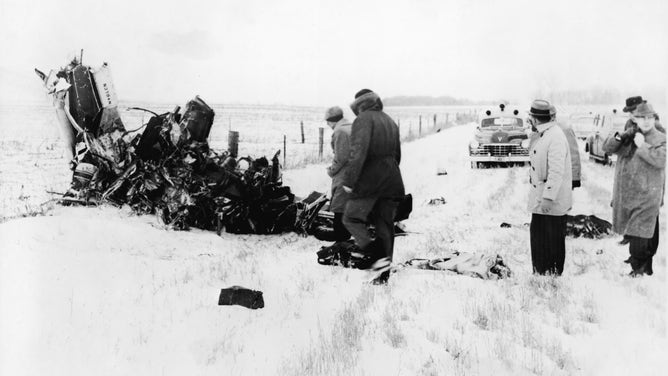
File: A group of men view the wreckage of the Beechcraft Bonanza airplane in a snowy field outside of Clear Lake, Iowa, early February 1959.
(Hulton Archive)
Declining winter weather conditions
Holly, Valens and Richardson got to the airport just after 1:30 a.m. The air was a brusque 15 degrees, and winds blew at around 36 mph at the Mason City, Iowa, airport. A cold front dropped from western Minnesota through Nebraska, with a secondary cold front across North Dakota, according to the report. Widespread snow preceded the fronts, along with gusty winds.
"The temperature and moisture content was such that moderate to heavy icing and precipitation existed in the clouds along the route," stated the report.
Air traffic controllers gave 21-year-old pilot Roger Peterson weather reports several times from 5:30 p.m. until takeoff. The pilot had been flying for about five years as a contract commercial pilot and flight instructor for the company that owned the plane, headed by Hubert Dwyer.
"He was a young married man who built his life around flying," the accident report said.
Two controllers gave weather reports to Peterson, which included conditions at Mason City and Fargo, along with one waypoint. Unfortunately, the NWS issued two "Flash Advisories" at night, indicating worsening conditions.
DOES EVERY PLANE NEED DEICING? THE SAFETY MEASURE WAS NOT ALWAYS STANDARD
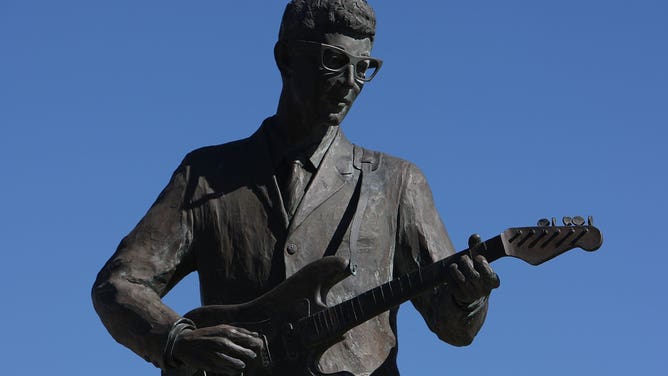
File: A statue of Buddy Holly at Buddy Holly Plaza in Lubbock, Texas.
(Ronald Martinez / Getty Images)
"Neither communicator could recall having drawn these flash advisories to the attention of Pilot Peterson. Mr. Dwyer said that when he accompanied pilot Peterson to ATCS (Air Traffic Control Service), no information was given to them indicating instrument flying weather would be encountered along the route."
Peters was only certified for Visual Flight Rules, or clear weather, not Instrument Flight Rules, flying in clouds. He passed the written exam for instrument flying but failed the practical flight check nine months before the crash. He logged 52 hours of instrument training, all taken with a conventional artificial horizon instrument, a gyro horizon.
The gyro horizon, now called an attitude indicator, shows the pilot if he is flying parallel to the earth, up or down. The indicator in the ill-fated Beechcraft Bonanza was a different type of indicator, an attitude gyro. "Exactly the opposite from that depicted by the conventional artificial horizon," according to the accident report.
The report pointed out that ATCS was responsible for giving the pilot all available information and to interpret the data if requested.
"At Mason City, at the time of takeoff, the barometer was falling, the ceiling and visibility were lowering, light snow had begun to fall, and the surface winds and winds aloft were so high one could reasonably have expected to encounter adverse weather during the estimated two-hour flight," the report continued.
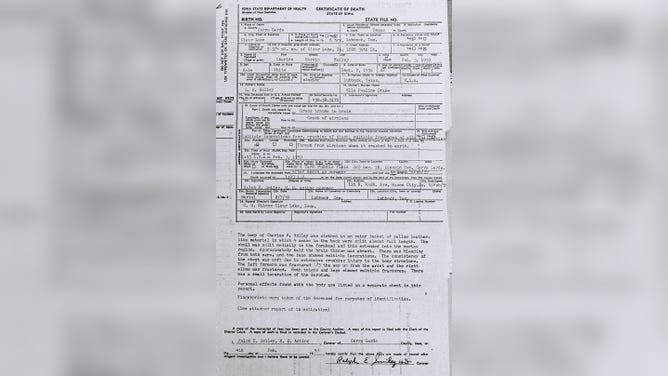
File: The official death certificate for Buddy Holly.
(Bob Modersohn / Getty Images)
The Analysis section of the accident report painted a tragic picture.
"There is evidence that the weather briefing consisted solely of the reading of current weather at en route terminal and terminal forecasts for the destination," the report stated. "Failure of the communicators to draw these advisories to the attention of the pilot and to emphasize their importance could readily lead the pilot to underestimate the severity of the weather situation."
The air traffic controller and Dwyer watched the plane take off around 1 in the morning. Dwyer told investigators that the plane took off normally and climbed. After about 5 miles, the lit tail of the plane descended gradually and then disappeared.
Air traffic tried to radio the pilot but got no response.

File: Personal effects from the Buddy Holly airplane accident scene found by a local farmer more than two months after the accident. Buddy’s lensless frames, dice, watch band, watch and watch backplate that possibly belonged to the Big Bopper, and a Zippo lighter.
(Bob Modersohn / Getty Images)
The crash
It wasn’t until 9 in the morning that Dwyer, flying overhead looking for the plane, found it under 4 inches of snow. Parts littered 540 feet of the remote field and the main wreckage lay against a barbed wire fence. The pilot was found in the plane, but the three musicians were thrown clear.
Investigators found evidence that the plane was set up for cruising and flying at an appropriate high speed, 165-170 mph. But, the plane was actually descending at 3,000 feet per minute and perpendicular to the ground when it hit.
The coroner's report said the plane skidded and/or rolled for 570 feet before the fence stopped it.
"The shape of the mass of wreckage approximated a ball with one wing sticking up diagonally from one side," said the coroner’s report.
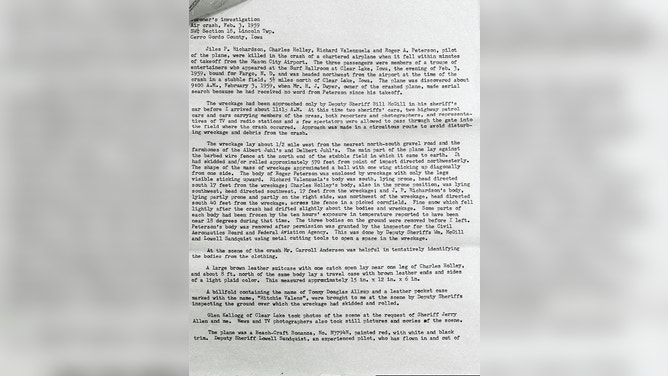
File: Official coroner’s investigation report (page 1) into the February 3, 1959 air crash that killed Buddy Holly, Ritchie Valens and The Big Bopper.
(Bob Modersohn / Getty Images)
Analysis pointed out that high gusty winds and turbulence would have caused the rate of climb and turn instruments to fluctuate "to such an extent that an interpretation of these instruments so far as attitude control would have been difficult to a pilot as inexperienced as Peterson."
"He could have become confused and thought that he was making a climbing turn when in reality he was making a descending turn," the report concluded.
The coroner said that parts of each body had been frozen over the 10 hours of exposure at about 18 degrees. The tour manager had to tentatively identify each body by clothing.
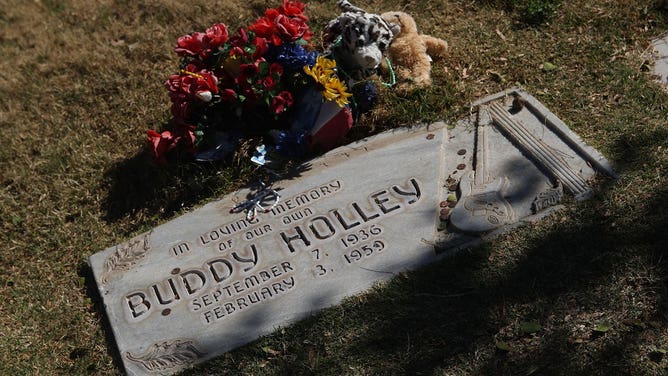
File: The headstone of Buddy Holly at the City of Lubbock Cemetery in Lubbock, Texas. Holley was the ancestral spelling of the star's name.
(Ronald Martinez)
Maria Elena Holly told the Australian Financial Review, 60 years after the crash, that she learned about it on TV. The shock caused her to miscarry her baby with her husband of 6-months. She missed the funeral.
She was supposed to attend the tour but canceled when she found out she was pregnant, said the review. She said she was terrified of small planes and that he would never have taken the flight if she had been with him.
